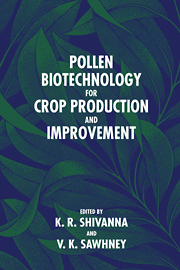Book contents
- Frontmatter
- Contents
- Contributors
- Foreword
- Preface
- 1 Pollen biology and pollen biotechnology: an introduction
- Part I Pollen biology: an overview
- Part II Pollen biotechnology and optimization of crop yield
- Part III Pollen biotechnology and hybrid seed production
- Part IV Pollen biotechnology and plant breeding
- 12 Barriers to hybridization
- 13 Methods for overcoming interspecific crossing barriers
- 14 Storage of pollen
- 15 Mentor effects in pistil-mediated pollen–pollen interactions
- 16 Pollen tube growth and pollen selection
- 17 Isolation and manipulation of sperm cells
- 18 Isolation and micromanipulation of the embryo sac and egg cell in maize
- 19 In vitro fertilization with single isolated gametes
- 20 Pollen embryos
- 21 Use of pollen in gene transfer
- Index
14 - Storage of pollen
Published online by Cambridge University Press: 11 September 2009
- Frontmatter
- Contents
- Contributors
- Foreword
- Preface
- 1 Pollen biology and pollen biotechnology: an introduction
- Part I Pollen biology: an overview
- Part II Pollen biotechnology and optimization of crop yield
- Part III Pollen biotechnology and hybrid seed production
- Part IV Pollen biotechnology and plant breeding
- 12 Barriers to hybridization
- 13 Methods for overcoming interspecific crossing barriers
- 14 Storage of pollen
- 15 Mentor effects in pistil-mediated pollen–pollen interactions
- 16 Pollen tube growth and pollen selection
- 17 Isolation and manipulation of sperm cells
- 18 Isolation and micromanipulation of the embryo sac and egg cell in maize
- 19 In vitro fertilization with single isolated gametes
- 20 Pollen embryos
- 21 Use of pollen in gene transfer
- Index
Summary
Summary
The pollen longevity of different species varies between minutes and years depending primarily on the taxonomic status of the plant and on abiotic environmental conditions. For a number of agronomically important taxa, including the short-lived graminaceous pollen, special storage conditions are needed to preserve the viability and fertilizing ability of pollen for a long period. Recent sophisticated methods such as nuclear magnetic resonance (NMR) spectrometry, Fourier transform infrared spectroscopy (FTIR), and different ultramicrotechniques for electron microscopy have helped to carry out precise studies on the water regime in pollen, parallel to the molecular changes occurring in membranes during pollen dehydration and rehydration. Cryopreservation seems to be the most efficient method for the long-term preservation (now up to 10 years) of partly dehydrated pollen grains. Beyond the classical role of “pollen banks,” the promising application of the modern in vitro techniques of plant biotechnology (isolation and fusion of reproductive cells, and DNA transformation of artificially produced zygotes and embryos) has opened new, challenging opportunities for germplasm cryopreservation in the near future.
Introduction
The artificial maintenance of the viability and fertilizing ability of pollen over a long period is an important problem from both the theoretical and practical points of view. Historically, the need to retain functional pollen for practical breeding and experimental research has launched detailed studies into pollen morphology, genetics, and physiology. As early as 1885, William King referred to the necessity for learning how to store pollen and stated, “Nothing could tend more to the speedy termination of an experiment than that we had control over the supply of pollen, so that we might use it when and where convenient to ourselves.”
- Type
- Chapter
- Information
- Pollen Biotechnology for Crop Production and Improvement , pp. 293 - 314Publisher: Cambridge University PressPrint publication year: 1997
- 22
- Cited by

